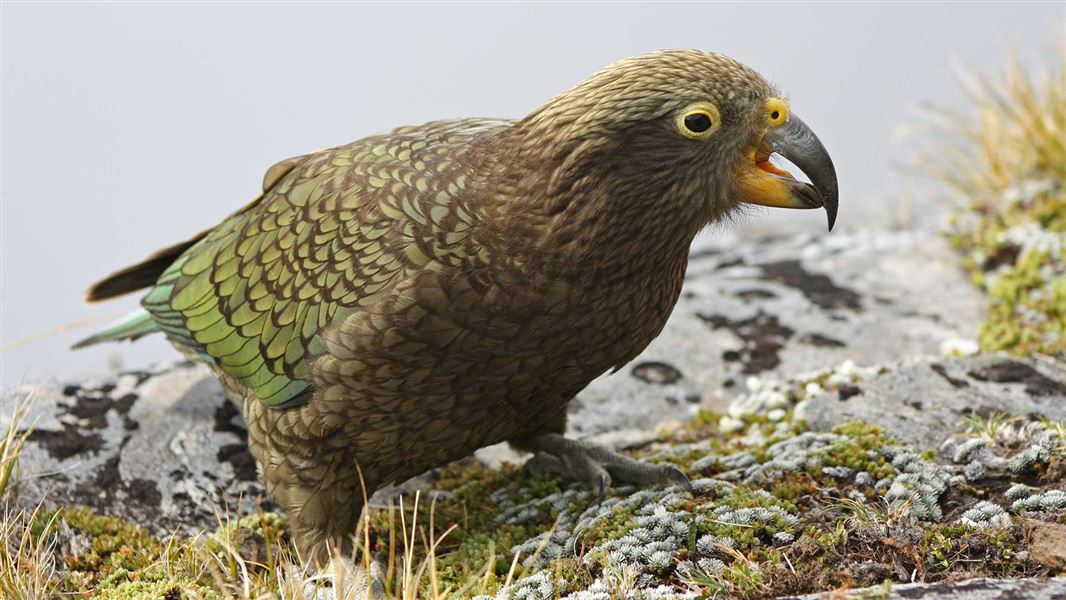Archived content: This media release was accurate on the date of publication.
Date: 12 December 2022
The DOC and OSPRI joint research is investigating whether the repellent, anthraquinone, can be used to reduce the risk of kea eating 1080 baits during aerial operations. A new method is being tested without the use of animal carcasses to lure kea, as trialled previously.
About 100 kea have been tracked by radio transmitter over the past six months to monitor their movements and survival. However, results of the trial won’t be known until hundreds of hours of video footage of kea interacting with the repellent bait are analysed. This will take several months.
DOC Landscapes Manager Peter Morton says predator control is crucial to stop the decline of kea populations, but unfortunately 1080 also poses a risk to kea, particularly in areas where they have learnt to scavenge from people.
“We chose to trial the repellent technique around Arthur’s Pass where kea are at a higher risk of eating 1080 bait due to their exposure to human food.
“Sadly, our monitoring found that seven kea died from 1080 toxin following the OSPRI Otira/Taipo operation in September and four kea died after the DOC Arthur’s Pass west operation in October.
“It’s too early to know whether the repellent method was effective in this trial. Until the results are analysed in coming months, we won’t know whether the kea that died, or other monitored kea, interacted with the repellent bait prior to the aerial operations.
“It’s upsetting and disappointing to lose kea, however, we know the kea population in this area will benefit significantly from reduced predation by stoats over the next two years, as will great spotted kiwi and other native species,” says Peter Morton.
The benefits to native wildlife are enhanced by the two aerial operations occurring within six weeks of each other, resulting in 73,000 ha where predators are suppressed. The likelihood of predator reinvasion is also reduced.
The remaining radio-tagged kea will be monitored over the next year to see if their survival benefits from the predator control.
The field trials involved exposing kea to non-toxic bait containing anthraquinone, which makes birds feel temporarily sick, to ‘teach’ them to avoid 1080 baits. Audio lures (kea calls) were used to attract kea to 25 ‘aversion training’ sites across the predator control areas, where their interactions with the repellent bait were filmed.
ZIP (Zero Invasive Predators) had trialled anthraquinone in multiple 1080 predator elimination operations as part of Predator Free South Westland, where animal carcasses were used to lure kea to sites where they were exposed to non-toxic repellent bait. DOC had also used this method in predator control in South Westland. The results showed promise, but further evidence was needed on the repellent’s effectiveness without animal carcasses, before being adopted more generally.
If aversion training repellent methods are proven to reduce the risk to kea, they will be added to DOC’s Code of Practice for use of 1080 in kea habitat.
A second repellent, d-pulegone, has also been trialled in non-toxic baits to see if kea dislike the peppermint-flavoured additive. The results are currently being analysed.
The predator control operations around Arthur’s Pass will help to eradicate bovine TB and protect other threatened wildlife such as kākāriki karaka/orange-fronted parakeet, roroa/great spotted kiwi, pīwauwau/rock wren and mohua/yellowhead, as well as native forests.
Background information
Research on repellents to keep kea safe – Media release 13 May 2022
Kea are a taonga for Ngāi Tahu and Ngā iwi o Te Tau Ihu (northern South Island iwi) and valued by New Zealanders. However, this highly intelligent parrot is in trouble. Predators such as stoats, possums and feral cats are the major cause of kea decline. Human impacts are another threat and include lead poisoning and being hit by cars.
Contact
For media enquiries contact:
Email: media@doc.govt.nz
